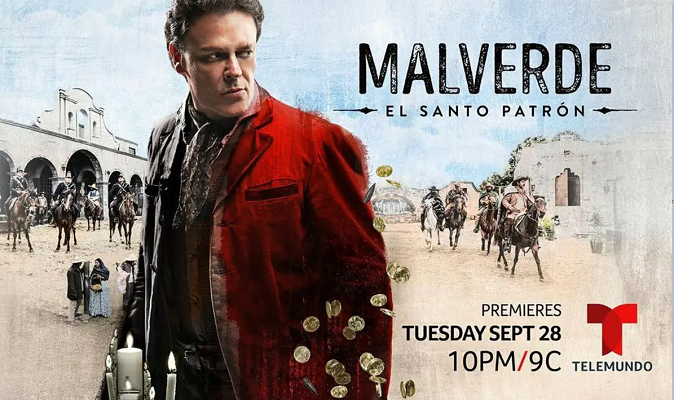TV Interview!

Interview with Executive Producer Karen Barroeta and actors Mark Tacher, Isabella Castillo and Alejandro Nones from “Malverde: El Santo Patrón” on Telemundo by Suzanne 9/13/21
I’m not a native Spanish speaker, so I don’t usually watch Telemundo. However, I did watch an episode or two of this series before our recent TCA panel with the actors. It was quite entertaining. The show is set in the old west and reminds me of the Western shows I grew up watching, such as Bonanza, The Big Valley, The Virginian and many more. There are a lot of characters in the show that you meet at once, though, so I had a little trouble sometimes telling them apart. It got a bit easier as time went on. The series has subtitles, so it’s easy to watch and get caught up in the story. It’s a timeless story of good versus evil. In fact, the main character is a bit like a sexy Robin Hood, but with some mystical powers. You should really check it out September 28 on Telemundo.
The panel included the executive producer and 3 of the actors. Unfortunately, the main star, Pedro Fernández, was not there, but the three that were there were very entertaining. The cast is from all different parts of Latin America. On the panel, Tacher is from Mexico; Castillo is from Cuba; and Nones is from Venezuela.
Curious, I asked EP Karen Barroeta if there are many western series on Telemundo. Her reply surprised me: “Actually, this is the first period piece we’ve produced, and we really worked on it for the past six years and thought that it could be something that audiences could be really interested in. So, it was a big challenge for us, but we are happy with the results. Hopefully, audiences will believe so as well.” I agree with her…I think audiences will enjoy it as I did.
She was also asked to compare the real-life tales of Malverde to their show. They did a lot of research into the folklore and then fleshed out the details in the story with fictional elements. They based their show on “what he meant for people and how he lost his parents and how he became a legend. He was part of the Yoreme. His family came from the Native — those Indians in Mexico, and so he learned how to create medicine to help people. So not only he was a Robin Hood, but he also had the ability to cure, and that’s how his name came about. So, we did take a lot from what it was recorded in history, but we did give it a bit of fiction in terms of the people that were around him and how he fought for justice.” Besides Malverde and the main characters created for the show, there are historical figures as well, such as president Porfirio Díaz and the revolutionary fighter Pancho Villa. “So, we brought a lot of reality in terms of the historical personas and characters that were real at that time, and so we incorporated it because we know that Malverde was fighting for justice. He was trying to help his people. And, so, I think it’s somehow very tied to how he was in reality. But, in TV, we like to make magic, and we brought some additional resources, elements, and characters, to make it more entertaining.”
She was also asked about what elements about Malverde’s character that they chose to put in (or not) , and she responded that they created the love story (between him and Carolina as well as him and Isabel) to make it more appealing to audiences. She seemed to feel bad that we were only asking her questions, so she suggested that the actors help answer this question. Tacher added that their story is not just a dry account of Malverde but a real story about how he lived and loved, which is what the audiences should like. Castillo chimed in to add that they really don’t know many details about Malverde, so they have to fill that in. And her character, La China Navajas, is based on many different women who fought for revolution in Mexico. She points out that they don’t really know if Malverde existed and whether he had these mystical powers that were attributed to him.
Someone else asked if Malverde was as well known as Emiliano Zapata. Karen said that it’s hard to compare the two because they’re very different Zapata was a revolutionary war hero and Malverde was a mythical figure – a saint. People have altars in Mexico, and his figure is frequently on their altars. Some have tattoos of him. He’s a saint in their culture. Actor Nones added his own take on it: “Zapata is someone kids studied in school, and Malverde is somebody that people from the north in Culiacán and Sinaloa grow with this in the streets. And people talk, and people follow him as a saint with a lot of devotion.”

Karen told us that it took six years to bring this project to the screen. They first did a lot of research and then put together a demo reel, which they showed to focus groups. They received a good reaction from them. “We saw how our audience here in the United States, an Hispanic audience, was so excited about knowing more, and so we just started the development process three years ago. And the pandemic started just when we were getting ready to start building the back lot that we built in Cumbres del Ajusco in Mexico. And, so, production all in all between the preproduction and the production – I can say was probably a year and a half. So, it’s been a project that took some time.”
Castillo confided that, since she grew up in Cuba, she’d never heard of Malverde until she traveled to Mexico. She discovered that many thought of him as the patron saint of Narcos, but he had nothing to do with them or the drug trafficking. He was a much more positive figure.
Nones had heard a lot about him during his travels and work in Mexico. Six years ago, he was in Culiacán and learned a lot about him at the chapel that bears his name from the son of the person who created the chapel.
Tacher, who, as I mentioned above, is Mexican, related that they don’t learn about pre-revolutionary characters like Malverde in Mexican schools. He heard about him later from people in Culiacán, Sinaloa, where he’s known as the patron saint of the needy. He let us know that Telemundo’s research into the saint was not easy because he’s most popular in certain areas of Mexico.
One of the other members of the press said that he’s also a teacher, so he had been concerned about whether Malverde would be a hero and a positive message. Karen told him, “This is a story of an amazing man who suffered being a young kid by having his father killed by the aristocrats, and he was raised by these Indians who taught him a lot about, like I said before, how to cure people. And he grew up seeing the difference between the aristocrats and the people that didn’t — that they would just fight to have food and education for their kids. So, he fought for justice. He aligned with the revolution to make sure he could bring some equality to those in need. And he was never, like, siding with criminals or with the real bandits. Yes, he did take maybe from the aristocrat’s gold mines, and he would give to the poor. But we are telling the story of a hero, of a legend, and that will show all positive traits. So, I’m not sure if we are necessarily saying it the way you commented it, but we are definitely bringing out this beautiful human being who fought for justice. And the way we position it is he would never want to shoot a gun to kill someone but just to defend himself. He would always say, ‘Never shoot to kill. Never do it.'”
The actors agreed with her that his story is a positive one. Tacher told us that there was virtually no drug trafficking in the world back at that time (the late 1800’s). Of course, that’s because most drugs were legal until the early part of the 20th century. Heroin, opium and pot were legal in Mexico until the 20’s and in the US until the 30’s.
Tacher was next asked why people seem to love stories of lawbreakers like Malverde. He replied thoughtfully: “I think we are always fascinated by those kinds of guys because they are always in the line of what is good or bad in the social medium — in a social medium, you know. So, it’s very difficult not to fall in love with these kinds of characters that help but also that dare to break a little bit — not to break but to bend the system a little bit. And they are always searching for new ways to bring joy to people even though they become a concern to other people. So that’s why I think we are always in love with these kinds of characters because they are almost always on the brink of success and failure.”
The actors were then asked what they had learned from doing their research for the show. Castillo really hadn’t known much about the Mexican Revolution, so she loved learning about it. Nones had previously done a play about the period, so he was already familiar with it. Tacher enjoyed “living” in the era where they had no electricity and shooting in a simple town where there were no cell phone signals. Then they did the scenes in the series where they brought electricity and light to the town. He said, Iit was amazing. It was like bringing Mexico to a new era. And I lived that way because I just thought to myself, ‘What would I do if I lived in that age without any kind of light?’ Yeah, you will survive, but that had to be hard.”
Castillo elaborated on what he said, explaining that the studio built this small town in the woods where there was nothing but a lot of cactus. She also mentioned that her character has a “controversial” storyline that is even difficult in today’s world (she never explained what she meant, but my guess is that her character is a lesbian). She went on, “we still have to fight for equality and for justice still in 2021, you know. So, when you go back to the good old days, it’s, like, oh, my god, since back in the day, people have been fighting for something that we are still fighting for today, you know. So, for us, it was, like, a joy. It was a pleasure to be part of this project and to participate in all of these historical events that still are taking place nowadays.”
There was a lot of joking around between the actors as they were asked to talk about their characters. That was very funny.
Nones plays Nazario Aguilar, the right hand to Malverde, who has an illness that makes it difficult if he gets injured. Aguilar risks his life for Malverde and because it’s the right thing to do. He loved being in the period piece with all of the details that make it seem authentic to the time.
Castillo loves her character and talked about how strong her character is. “She doesn’t change who she is for anyone, and she has actually taught me many things. She came to Malverde’s life when she was an orphan. Pretty much they killed her whole entire family.” She finds a family with Malverde and Aguilar. Castillo loves the other actors, the action and “choosing characters that break the stereotypes,” such as this woman who had to survive alongside men. She continued, “What I love about my character is that she’s the only girl in a band of only men, and she manages to survive back in the day, 1910, which it was difficult to be a girl surrounded by men because you would have to make them respect you, you know. And she gained the respect from men, and that’s something that’s really, really valuable, especially back in the day.”
The female soldiers are called “Soldaderas” and Tacher pointed out that there’s an old Mexican song called “La Adelita” about the women soldiers of the revolution. His character is Vicente del Rio, who is ” an American-born, greedy entrepreneur that moves to the north region of Mexico because he knows of its riches, but sooner than later, he didn’t know that he would fall in love with our beautiful protagonist, Isabel.” There is a lot of conflict between del Rio and Malverde (in part because Malverde and Isabel had a past relationship). Castillo then teased Tacher about del Rio’s mustache, and they joked around because he didn’t like wearing the mustache at all.
MORE INFO:

Set in 1910 and inspired by real events, ‘Malverde: El Santo Patrón’ tells the story of Jesús Juárez “Malverde,” one of the biggest and most controversial Mexican characters of the last 150 years, an outlaw who ultimately became a legendary figure, a religious icon, and protector of the innocent, poor and dispossessed. The high-octane production shows the life of Malverde, from his turbulent childhood as an orphan in Sinaloa, Mexico, through his young adulthood during the Mexican Revolution, when he encountered war and danger as well as romance. Rising to heights of unexpected power, he became a Robin Hood-type figure admired by women from all social classes but tormented by unresolved feelings for his childhood girlfriend, Isabel. With the federal authorities increasingly concerned with Malverde’s steadily growing power in the early years of the Revolution, it will take more than love or God to safeguard the hero known as “El Santo Patrón” from those out to destroy him.
Karen Barroeta
Karen Barroeta is a television industry executive with more than 20 years of experience in broadcast, pay TV & content distribution. Throughout her career, Karen has been responsible for leading efforts in Programming, Creative, Marketing, PR and Ad Sales for international and Hispanic-language markets and has cultivated a strong expertise in media management and strategic thinking. Karen is a forward-thinking, results-driven executive who has excelled at leading teams improving the quality of the creative output, enhancing productivity as well as improving operational and communication workflows while building internal partnerships.
Recently, Karen has been appointed Executive Vice President of Production and Development at Telemundo Global Studios. In this new role, Barroeta is responsible for leading the development strategy of the Studios, along with the management and execution of long-form scripted productions across all platforms. She will also oversee the alternative content team and identify projects for pilots, behind-the-scenes productions and digital capsules.
In addition, Karen works closely with Marcos Santana, President of Telemundo Global Studios, to jointly manage and execute long-form scripted productions across all platforms.
Previously, Karen successfully held the Senior Vice President role of Marketing and Creative for Telemundo Network and Universo including Entertainment, News & Sports. In this role, Barroeta was part of the network’s core content team leading the strategic development and execution of all brand and consumer-marketing initiatives across the company’s platforms, including oversight of the media planning and experiential practices. She also collaborated with Telemundo Station Group and NBCUniversal distribution and affiliate teams while leading the Shared Services & scheduling strategies
Karen holds an MBA from the University of Miami, a Master of Arts in Television Production & Digital Media from Emerson College, and a Bachelor of Arts in Communications from Florida Atlantic University.
Mark Tacher
Mark Tacher is a Mexican actor born in Mexico City. He has a degree in acting from CEFAT (Tv Azteca Actoral Training Center). In addition, he studies music, guitar, singing and DJ at the G Martell academy in Mexico. He perfected his vocal technique with maestro Óscar Sámano (MET from NY and student of Pavarotti) in Mexico. Years later he studied Actoral Perfection Techniques, The truth without effort in Venezuela.
His artistic career debuted in 1996 as a host on the Tv Azteca program “Nintendomanía” and which lasted until 1998 when he began his role as an actor.
“Perla”, “Trestimes Sofía” and “Háblame de amor” were his first acting projects. In 2000 he had his first leading role in “Tío Alberto” and 2002 “Get on my motorcycle.” In 2003 he participated in “Mirada de mujer, el returno” being his last novel on Tv Azteca.
He recently participated in the Queen of the South 2 giving life to Alejandro Alcalá and Operación Pacífico from the hand of Telemundo, the latter being one of the protagonists giving life to Colonel Gabriel Pedraza.
Isabella Castillo
Isabella Castillo was born on December 23, 1994 in Havana, Cuba. She was born in a musical family, her mother Delia Diaz de Villegas was a known singer in the island. Her father, Jose Castillo is a drummer and her sister Giselle Castillo graduated from the university in Music Education. In 1997 she migrated to Belize City and months later she moved to Miami, Florida (USA). At the age of 5 years, she decided she wanted to sing in one of her mother’s show, she blew them away with her powerful voice and small age. She took voice, dance and acting lessons. In 2007 she went to Madrid, Spain for a casting for the musical Ana Frank – Un Canto a la Vida. She got the part of Anne Frank and moved with her parents to Spain. She received the award Premio Gran Via for Best Revelation in a Musical. When the musical ended she came back to the United States and was casted to play the part of Andrea Giron in El Fantasma de Elena with Telemundo. After the end of this soap opera she was casted for Grachi and became the main character in the TV series Grachi for Nickelodeon. She won the Nickelodeon’s Kids Choice Awards Mexico 2011 for Best Female Artist in a TV series. Right now she finished filming Grachi second season and is traveling through out Latin America with Grachi the Musical.
Alejandro Nones
Alejandro Nones (born December 9, 1982) is a Venezuelan actor and model. He began his acting career in Mexico, on film Así del precipicio, and later was hired by Televisa to act in the telenovela Lola, érase una vez. He is an actor and producer, known for Who Killed Sara? (2021), Cuna de Lobos (2019) and Amar a muerte (2018).
Proofread and Edited by Brenda
Back to the Primetime Articles and Interviews Page


